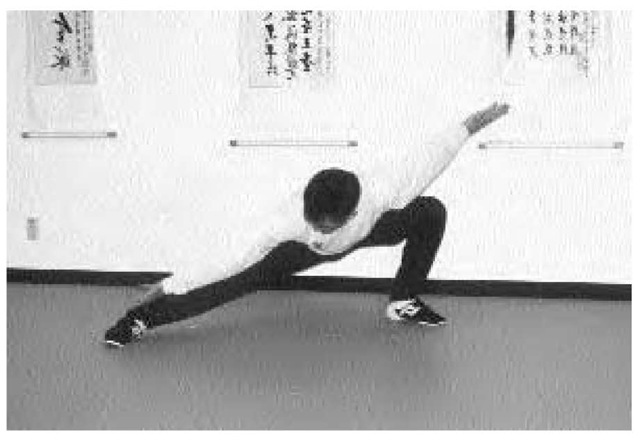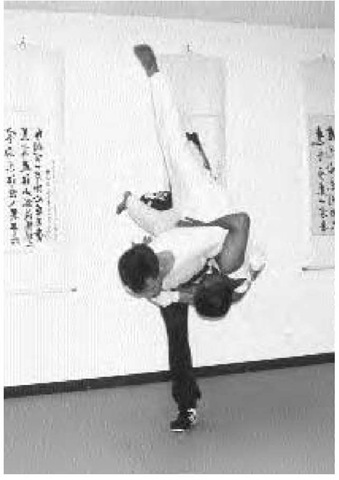Of the four internal martial arts of China, the most distinctive appearing is baguazhang. The name means “eight-trigram palm,” in reference to the bagua (eight-trigram) pattern used in Chinese philosophy, magic, and fortune telling. Part of the training in baguazhang is walking a circle while practicing certain moves, and this walking a circle gives the art its distinctive appearance. The bagua practitioner walks a circle of various sizes, reversing his movement, twisting and turning through eight sets of movements (called palms for the hand position used). Between the sets of movements, he walks the circle with his hands in one of the eight positions.
While a few claims of baguazhang’s origins go back to the fifteenth century, most experts believe the art originated with Dong Haichuan (1789-1879), who claimed to have learned the method of divine boxing from a Daoist, who is sometimes given the name of Dong Menglin. Dong Haichuan used no name, claiming only that he learned from an old man in the mountains. He became a servant or possibly a eunuch in the Imperial Palace and, because of his graceful movements, was one day asked to demonstrate his skill at martial arts. The twisting, turning beauty of baguazhang impressed the emperor, and Dong Haichuan became a bodyguard and instructor to the court. Of his many students, five learned the art fully and formed the schools of baguazhang taught today: Cheng Tinghua, Li Cunyi (Li Tsun-I), Yin Fu, Zhang Zhaodong, and Liang Zhenpu. Many variations of baguazhang are practiced today and, depending on who is counting, there are five to fourteen substyles. The most popular today appear to be Emei, Wudang, Cheng family, Yin family, and Yin Yang.
Many stories are told about Dong Haichuan. The most famous tells how Dong fought Guo Yunshen for three days, with neither being able to win. Impressed with each other’s techniques, they began cross-training their students in the two arts. More probable is the story that many masters of both systems lived in this province, and many of them became friends, especially bagua’s Cheng Tinghua and xingyiquan’s Li Cunyi (Li Tsun-I). The linear drills practiced in some styles of baguazhang are believed to descend from the interaction with xingyi. The style taught by Zhang Junfeng, a student of Cheng Tinghua, for example, teaches eighteen exercises that are fairly linear in nature.
Baguazhang is closely associated with Daoist yoga or inner alchemy and other Chinese esoteric traditions. Cultivation of inner energy (qi) and breathing practices are taught along with the fighting techniques. A student of baguazhang practices these moves at the Shen Wu Academy of Martial Arts in Garden Grove, California.
It has been suggested that baguazhang is a descendant of certain Daoist schools that practice moving meditations while walking in a circle. Baguazhang is still practiced as a form of qigong (exercise that develops psychophysio-logical energy) and Daoist yoga as well as a fighting art.
The student in baguazhang begins by learning to walk the circle. In the beginning, the circle is six to twelve feet in diameter. As mastery of the art is obtained, the circle can be as small or large as needed. Initially, the student walks the circle while concentrating on moving correctly and breathing. In the old days, this could continue for as long as three years. When the student is able to move correctly, he is introduced to the single and then double palm changes. After this foundation is learned, the student learns the eight mother palms. This is a long form that consists of eight sets of movements done to both sides, separated by periods of walking the circle in different positions. When observed, the bagua player is seen to go through patterns of fluid movement, fluidly twisting and turning in both high and low stances. Between these periods of activity, he tranquilly circles.
After he attains a certain degree of proficiency, the student is introduced to two-person drills, pole training, and weighted training. Two-person training teaches him how the movements of the form conceal striking, grappling, and throwing techniques and also how to respond to an opponent. Pole training and weighted training teach power transfer and condition the body. Other techniques are used to train the development and release of applied internal power (jing). As the training continues, the student may learn other forms, such as swimming-body baguazhang, as well as weapon techniques. The range of baguazhang forms is great: Thirteen empty-handed forms, five two-person forms, and sets for the standard Chinese weapons exist.
When fighting, baguazhang practitioners twist and weave about their opponents, emphasizing the use of the open hand in preference to the closed fist. Two men demonstrate a throw using this distinctive technique at the Shen Wu Academy of Martial Arts in Garden Grove, California.
When fighting, the baguazhang practitioner twists and weaves about his opponents, entrapping limbs and striking to vital points. Drills exist to train for multiple enemies that are similar to Hebei xingyi’s Nine Palace Boxing, and it is claimed baguazhang allows one to fight eight opponents simultaneously.
The elusive and entrapping nature of this style has given rise to the analogy that baguazhang is like a wire ball, where attacks are trapped and twisted around.
While baguazhang uses the standard Chinese arsenal of jian (two-edged sword), dao (broadsword or cutlass), qiang (spear), gun (staff), dao (long saber), gou (hook sword), double knives, and guai (crutch), it also has two specialized weapons: a metal ring like a hoop and the lu jiao dao (deer hook sword). This latter weapon, unique to baguazhang styles, looks like two crescents interlocked to create a weapon with points. Used in pairs, the swords are close-quarter weapons designed to trap and destroy the enemy.


